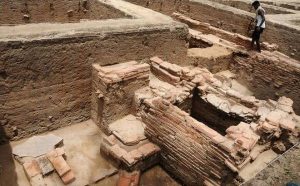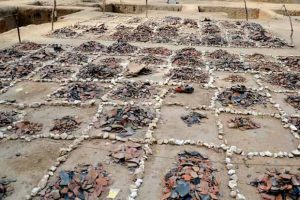New information provided by methods of radiocarbon dating and accelerator mass spectrometry has presented archaeologists with a more accurate timeline regarding the site of Keeladi, a small village which bordered the districts of modern-day Madurai and Sivagangai in Tamil Nadu, India (Figure 1). In an article written by Dennis Jesudasan of The Hindu, Jesudasan details aspects of the recent discovery. “Six carbon samples collected from the fourth season (2018) of excavations at Keeladi were sent to Beta Analytic Lab, Miami, Florida, U.S., for Accelerator Mass Spectrometry (AMS) Dating” (Jesudasan, 2019). Originally, the Sangam Era was thought to be had taken place between 300 BC. and 300 AD. However, data collected from recent radiocarbon and accelerator mass spectrometry samples indicate that the site had been occupied 300 years prior than originally thought, thus placing its existence between 600 BC. and 100 AD.
The relevance of this newly discovered evidence plays a significant role in constructing the culture of this civilization during the Sangam Era in South India. Initially, it was considered that although the Sangam Era produced numerous literary documents, this aspect of their culture was not developed until third century BCE. However, since the Tamil Nadu Archaeology Department of India announced the newly reported dates, it can be inferred that literacy among the population was prevalent as early as sixth century BCE. Furthermore, as radiocarbon dating continues to allow archeologists to develop a better understanding of the culture and human activity during the Sangam Era, it further assists in dating the origin of the Tamil-Brahmi script to sixth century BCE.
Among surveys which included radiocarbon dating and accelerator mass spectrometry, materials recovered from a 2018 excavation of the site continue to portray the human activity within the village of Keeladi (Figure 2). Materials such as spindle whorls, bone tipped tools, and numerous fragments of terracotta spheres indicate that the village of Keeladi was relatively industrial and most likely produced textiles as a means of trading. Continued portrayal of human activity within the village Keeladi was developed as animal bone samples were sent to Pune’s Deccan College of India and determined to be the bones of various farm animals, thus illuding to an agricultural aspect of the small village. As a result of the combined efforts of archeology, such as radiocarbon dating and accelerator mass spectrometry, there now exists a more comprehensive understanding regarding the village of Keeladi.
References:
Jesudasan, Dennis S.
2019 Keezhadi excavations: Sangam era older than previously thought, finds study. The Hindu. The Hindu, Accessed September 20, 2019
Saju, M. T.
2019 Sangam age is older than previously thought, carbon dating of Keeladi materials suggests: Chennai News – The Times of India, Accessed September 19, 2019
Saraceni, Jessica E.
2019 New Dates Push Back Creation of India’s Tamil-Brahmi Script. Archaeology Magazine. Archaeology Institute of America, Accessed September 20, 2019
Images:
2019 Hoary past: One of the samples collected at the depth of 353 cm goes back to 580 BCE. Keezhadi excavations: Sangam era older than previously thought, finds study. The Hindu, Accessed September 20, 2019
www.thehindu.com/news/national/tamil-nadu/keeladi-findings-traceable-to-6th-century-bce report/article29461583.ece
2017 Artefacts unearthed at Keezhadi archaeological site at Sivaganga district. Keezhadi might have been an industrial town: Archaeologist. Daith Thanthi, Accessed September 20, 2019
www.dtnext.in/News/TamilNadu/2017/09/11021312/1045201/Keezhadi-might-have-been-an-industrial-town-Archaeologist.vpf
Additional Content:


